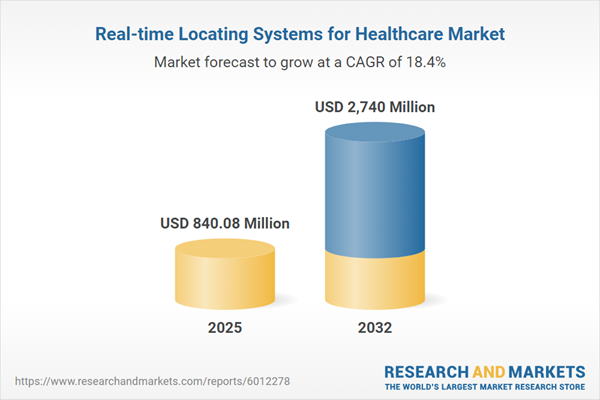Speak directly to the analyst to clarify any post sales queries you may have.
The Real-time Locating Systems for Healthcare Market is evolving rapidly, driven by institutional needs for improved operational efficiency, better asset management, and continuous patient safety advancements. This report provides senior healthcare leaders and technology strategists with clear insights to capture emerging opportunities and mitigate evolving risks within the global real-time locating landscape.
Market Snapshot: Real-time Locating Systems for Healthcare
The Real-time Locating Systems for Healthcare Market grew from USD 709.09 million in 2024 to USD 840.08 million in 2025. It is expected to continue expanding steadily at a CAGR of 18.42%, reaching USD 2.74 billion by 2032. Rapid digitization of care facilities and increased focus on workflow automation are primary growth drivers, reinforced by regulatory influences and the rising importance of interoperability, robust data privacy, and seamless integration within healthcare digital infrastructure. Stakeholders are leveraging these systems to address the escalating challenge of asset tracking, patient throughput, and regulatory compliance while optimizing resources in high-acuity settings.
Scope & Segmentation of the Healthcare RTLS Market
This research provides granular analysis and forecasts across several critical market dimensions:
- Technology Type: Bluetooth Low Energy, Infrared, RFID (including Active RFID and Passive RFID), and Wi-Fi.
- Deployment: Cloud-based and On-Premise implementations, enabling organizations to balance speed with data governance requirements.
- End User: Ambulatory Surgical Centers, Clinics and Diagnostic Centers, Hospitals—each with unique workflow, integration, and scalability requirements.
- Application: Asset Tracking, Infant Protection, Patient Tracking, Staff Tracking, and Temperature Monitoring, reflecting the diverse operational demands in modern healthcare.
- Region: Americas (with discrete focus on North America: United States, Canada, Mexico, and Latin America: Brazil, Argentina, Chile, Colombia, Peru); Europe, Middle East & Africa (Europe: United Kingdom, Germany, France, Russia, Italy, Spain, Netherlands, Sweden, Poland, Switzerland; Middle East: United Arab Emirates, Saudi Arabia, Qatar, Turkey, Israel; Africa: South Africa, Nigeria, Egypt, Kenya); Asia-Pacific (China, India, Japan, Australia, South Korea, Indonesia, Thailand, Malaysia, Singapore, Taiwan).
- Key Companies: Stanley Black & Decker, Zebra Technologies, CenTrak, Sonitor Technologies, Quuppa, Versus Technology, Ekahau, Ubisense, Impinj, and TeleTracking Technologies.
Key Takeaways for Senior Decision-Makers
- Real-time Locating Systems for Healthcare drive actionable insights, supporting proactive equipment allocation, improved patient safety, and streamlined clinical workflows.
- Modern RTLS solutions leverage combinations of Bluetooth, RFID, and Wi-Fi for diverse hospital environments, enabling essential integration with electronic health records and IT ecosystems.
- Increased demand for both cloud-hosted and on-premise deployments allows institutions to align solutions with security and data sovereignty obligations.
- Regional adoption is shaped by varying infrastructure maturity, government digitization policies, and local regulatory frameworks, prompting tailored vendor strategies across Americas, EMEA, and Asia-Pacific.
- As expectations for transparency and patient-centric care intensify, investments in RTLS-enabled mobile applications and analytics dashboards are accelerating, supporting better patient navigation and resource optimization.
- Emerging industry alliances and ongoing product innovation—such as enhanced sensor miniaturization and new workflow applications—are shifting the competitive landscape while increasing solution value for healthcare providers.
Tariff Impact on Healthcare RTLS Supply Chains
Tariff measures in the United States implemented in 2025 have introduced heightened complexity for stakeholders. Higher import duties on key RTLS components prompt increased manufacturing diversification and a greater focus on sourcing from low-duty or nearshore locations. This also influences distribution strategies, with regional assembly hubs supporting more resilient logistics. Procurement teams adjust by seeking alternatives with more advantageous classifications, while service providers emphasize integrated support and managed services to maintain value and stable pricing in response to cost volatility.
Methodology & Data Sources
This analysis combines primary interviews with senior healthcare executives, technology partners, and integrators to capture diverse perspectives, while secondary data from industry reports, regulatory filings, and academic sources provides essential context. Quantitative evaluation of adoption rates and implementation case studies informs segmentation accuracy. Rigorous cross-checking ensures transparent, dependable findings relevant to the real-time locating systems for healthcare market.
Why This Report Matters
- Enables IT and operational executives to benchmark RTLS strategies, addressing asset management, patient flow, and compliance objectives across a range of care settings.
- Supplies evidence-based insights to inform partnership, sourcing, and investment decisions against evolving regulatory and supply chain headwinds.
- Equips vendors with intelligence on market dynamics, buyer priorities, and regional opportunities, supporting agile roadmaps and competitive differentiation.
Conclusion
Healthcare organizations embracing RTLS technologies are better positioned to achieve operational efficiency and adapt to sector-wide digital transformation. Detailed segmentation, tariff analysis, and practical recommendations support informed, future-facing decision-making for all key stakeholders.
Additional Product Information:
- Purchase of this report includes 1 year online access with quarterly updates.
- This report can be updated on request. Please contact our Customer Experience team using the Ask a Question widget on our website.
Table of Contents
3. Executive Summary
4. Market Overview
7. Cumulative Impact of Artificial Intelligence 2025
Companies Mentioned
The companies profiled in this Real-time Locating Systems for Healthcare market report include:- Stanley Black & Decker, Inc.
- Zebra Technologies Corporation
- CenTrak, Inc.
- Sonitor Technologies AS
- Quuppa Oy
- Versus Technology, Inc.
- Ekahau, Inc.
- Ubisense Group Limited
- Impinj, Inc.
- TeleTracking Technologies, Inc.
Table Information
| Report Attribute | Details |
|---|---|
| No. of Pages | 194 |
| Published | October 2025 |
| Forecast Period | 2025 - 2032 |
| Estimated Market Value ( USD | $ 840.08 Million |
| Forecasted Market Value ( USD | $ 2740 Million |
| Compound Annual Growth Rate | 18.4% |
| Regions Covered | Global |
| No. of Companies Mentioned | 11 |









